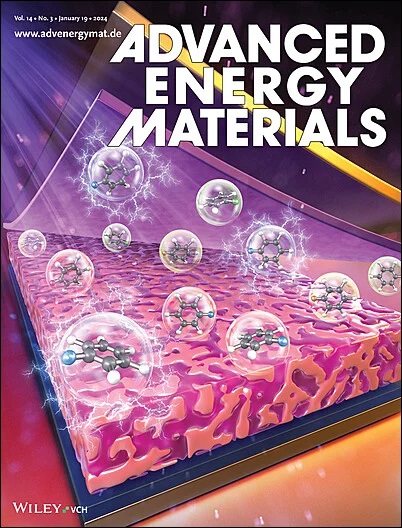通过磁光显微镜揭示二维钙钛矿中的局部暗激子种群
IF 24.4
1区 材料科学
Q1 CHEMISTRY, PHYSICAL
引用次数: 0
摘要
光电器件的成功开发取决于对光活性材料中光与激发态之间相互作用的详细理解。在二维钙钛矿中,激子是主要的光生物质,它们的能量结构起着关键的作用,控制着光子的吸收和发射过程。在这些材料中,由于选择规则的放松,暗激子态可以进行光致发光,并且该过程可以通过外部磁场进行调制,从而能够明确地识别激子的精细结构。先前关于二维钙钛矿磁光光谱的报道仅限于宏观响应,其中关于光致发光的微观非均质性的关键信息丢失。本文首次在钙钛矿材料上使用磁光学显微镜来阐明激子发射过程的空间变化。在二维钙钛矿薄膜中,局部亮和暗激子种群的区域被区分出来,这与薄膜的形态有关。在单晶中,暗激子被定位在边缘,激子可以被困在两种不同类型的亚隙状态中。这项工作在理解二维钙钛矿激子发射特性方面取得了重大进展,这对光电技术的发展和优化至关重要。本文章由计算机程序翻译,如有差异,请以英文原文为准。
Revealing Localized Dark‐Exciton Populations in 2D Perovskites via Magneto‐Optical Microscopy
The successful development of optoelectronic devices is contingent on a detailed understanding of interactions between light and excited energy states in photoactive materials. In 2D perovskites, excitons are the dominant photogenerated species and their energetic structure plays a pivotal role, governing photon absorption and emission processes. In these materials, dark exciton states can undergo photoluminescence due to relaxation of selection rules and this process can be modulated by an external magnetic field, enabling unambiguous identification of the exciton fine structure. Previous reports of magneto‐optical spectroscopy on 2D perovskites are restricted to the macroscopic response, where key information is lost regarding the microscopic heterogeneity of the photoluminescence. Here, magneto‐optical microscopy is used for the first time on perovskite materials to elucidate the spatial variation of exciton emission processes. In 2D perovskite thin films, regions of localized bright and dark exciton populations are distinguished, correlated to the film morphology. In single crystals, dark excitons become localised at the edges, where excitons can be trapped in two distinct types of sub‐gap states. This work represents significant progress in understanding the properties of exciton emission in 2D perovskites, which is crucial for the development and optimization of optoelectronic technology.
求助全文
通过发布文献求助,成功后即可免费获取论文全文。
去求助
来源期刊

Advanced Energy Materials
CHEMISTRY, PHYSICAL-ENERGY & FUELS
CiteScore
41.90
自引率
4.00%
发文量
889
审稿时长
1.4 months
期刊介绍:
Established in 2011, Advanced Energy Materials is an international, interdisciplinary, English-language journal that focuses on materials used in energy harvesting, conversion, and storage. It is regarded as a top-quality journal alongside Advanced Materials, Advanced Functional Materials, and Small.
With a 2022 Impact Factor of 27.8, Advanced Energy Materials is considered a prime source for the best energy-related research. The journal covers a wide range of topics in energy-related research, including organic and inorganic photovoltaics, batteries and supercapacitors, fuel cells, hydrogen generation and storage, thermoelectrics, water splitting and photocatalysis, solar fuels and thermosolar power, magnetocalorics, and piezoelectronics.
The readership of Advanced Energy Materials includes materials scientists, chemists, physicists, and engineers in both academia and industry. The journal is indexed in various databases and collections, such as Advanced Technologies & Aerospace Database, FIZ Karlsruhe, INSPEC (IET), Science Citation Index Expanded, Technology Collection, and Web of Science, among others.
 求助内容:
求助内容: 应助结果提醒方式:
应助结果提醒方式:


